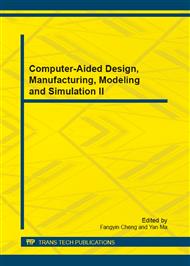p.3
p.7
p.12
p.17
p.22
p.28
p.33
p.37
The Performance of Steel Beams in the High Temperature
Abstract:
To study the performance of steel at elevated temperatures, the stress and deformation of steel beam were analyzed under high temperature in this paper. During the analysis, the properties of steel material must be defined firstly, which are the decisive factor affecting the carrying capacity of steel beam. The mechanical and physical properties of steel at high temperatures were accessed accordance to the provisions of the European specification in analysis. The finite element program ANSYS was used to analyze the constraints steel beam, which subjected to the uniformly line loads, then the steel beam was heated up continuously, and the mechanical properties and deformation of the steel beam was analyzed at different temperatures. The regularity of mid-span deflection changing with temperature was concluded, so as the variation of axial stress at both ends of the steel beam.
Info:
Periodical:
Pages:
3-6
Citation:
Online since:
December 2012
Authors:
Keywords:
Price:
Сopyright:
© 2013 Trans Tech Publications Ltd. All Rights Reserved
Share:
Citation:


